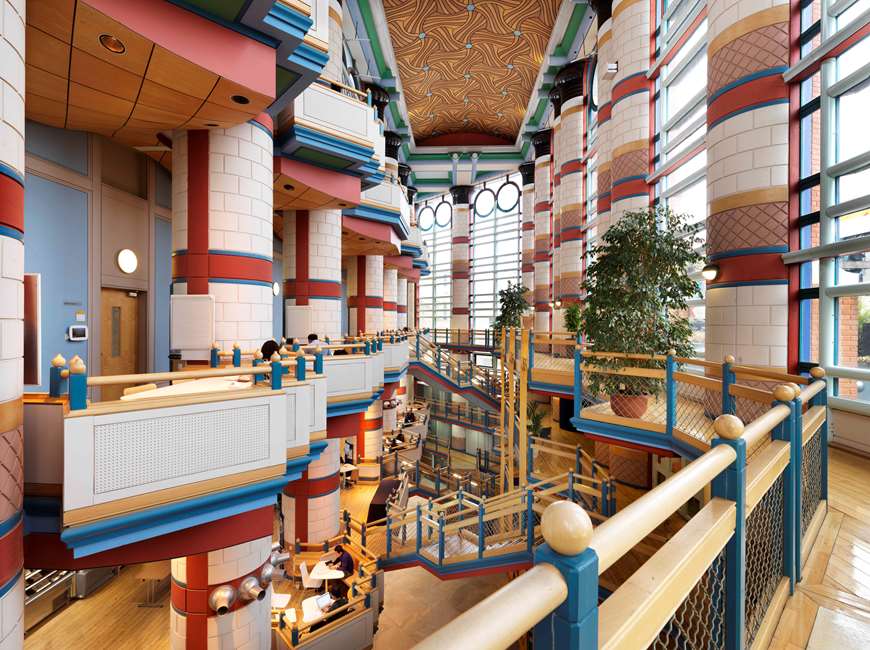11 May 2018 | Updated 16 May 2018
17 bold, playful, brightly coloured - or hideous carbuncles, depending on your view - Post-Modern buildings of the late 1970s to 1990s have been listed for protection status meaning that their facilities managers will forever be challenged to maintain the joy of these desolate concrete hulks.
From Crown Courts in Cornwall, to warehouses in Slough and housing schemes in London’s Docklands, the listings follow Historic England’s research into this architectural style and recommendations that the Department for Digital, Culture, Media and Sport give these buildings heritage protection.
Post-Modernism
Post-Modern architecture emerged in the 1970s, strangely coming in the wake of Modernism. In Britain it was closely associated with the economic boom of the 1980s.
Duncan Wilson, Chief Executive of Historic England, said: “Post-Modern architecture brought fun and colour to our streets. Housing schemes were enlivened with bold façades, a school technology building was decorated with columns designed as screws, a business park injected with glamour. These are scarce survivals of a really influential period of British architecture and these buildings deserve the protection that listing gives them.”
Commercial Buildings
McKay Trading Estate, Blackthorne Road, Poyle, Slough (Grade II)
This was the first independent commission for architect John Outram. This design for a group of warehouses and offices is an early example of Post-Modernism and was completed over 1976-1978, showing an intriguing level of thought for the composition of an industrial building. The building is characterised by the arches on its façades: the façade facing the street has an arcade of five full height arches and the long elevation of the warehouses has pairs of arches in the style of Le Corbusier and Louis Kahn. The arches are divided by brick piers with cast concrete capitals. The façades are almost completely flat, so the interplay between windows and frames and brick and concrete reference ‘trompe l’oeil’ - the visual illusion in which painted detail tricks the eye into seeing three dimensional objects. The three separate parts of the site: the building, forecourt and car parking, define the space and represent an urban piazza, and along with the arcading of the façades, underline Outram’s evocation of traditional European squares.
210, 220, 240, 250, 260 and 290 Park Avenue, Aztec West, South Gloucestershire (Grade II)
Aztec West was a pioneering business park with a planned, landscaped campus in a semi-rural location close to the M4 motorway and Bristol. The earliest buildings on the park were designed in the High-Tech style, reflecting the ultra-modern nature of the park. The brief required flexible office space for multiple tenants. Architect CZWG’s response was a Post-Modern design, based on two intersecting squares with internal courtyards at the centre. The circular forecourts followed the turning circle of a car, the only way out-of-town developments could thrive. Art Deco design such as the over-scaled building numbers used as canopies over the main doors (now removed). The buildings have high, continuous parapets that hide the mono-pitch roofs into the internal courtyards. Beneath the parapets, double-height windows give a sense of scale and grandeur and act as Classical columns around the building. The two-storey buildings have banded cladding of red and buff brick.
Education
Judge Business School, Cambridge (Grade II)
In the 1990s, a competition was held to convert the former Addenbrooke Hospital on Trumpington Street into a business school. The mid-18th century hospital was listed Grade II in 1986. John Outram won the competition in 1991 and design work started in the same year. He kept the 19th century arcaded façade of the hospital and rebuilt the early 20th century attic storey. The two three-storey war blocks were converted to the library, seminar rooms and offices. The different elements of the building are linked by a large glazed atrium.
The building has been listed at Grade II, the second highest grade because of this being a remarkable piece of Post-Modern architecture and a new work that complements an existing listed building.
Katharine Stephen Rare Books Library, Newnham College, Cambridge (Grade II)
Newnham College, Cambridge commissioned Joanna van Heyningen and Birkin Haward to design a library to store their rare books, manuscripts and artefacts. The Katharine Stephen Rare Books Library was built in 1981-1982 and was named after the person who was for many years responsible for the library at the College before becoming Principal between 1911 and 1920. The barrel-vaulted roof was inspired by the College’s first library.
Gough Building, Bryanston School, Dorset (Grade II)
The school is set in the grounds of a Grade I listed country house. Responding to a competition to design the new building in the mid-1980s, Exterior bays are separated by columns which stand beyond the height of the first floor of the building, modelled to look like giant screws and made of cast white stone. It is a decorative feature which plays a functional role, to unify the design, signify the purpose of the building, and through the ‘capital’ at the top to deflect sunlight.
Law and Government
Truro Crown Courts, Cornwall (Grade II)
The Courts Act of 1971 was issued with an accompanying memorandum on court design. Truro Courts of Justice is in response to this brief, providing courts on as few floor levels as possible and separate facilities for judges and juries.
Civic Buildings
Hillingdon Civic Centre, High Street, Uxbridge, London (Grade II)
Hillingdon Civic Centre was built between 1973 and 1979 by one of the foremost post-war architectural practices, Robert Matthew Johnson-Marshall (RMJM). The partner in charge was Andrew Derbyshire, at that time recognised as a committed Modernist. As an early example of English Post-Modernism which creatively reinterprets the Arts and Crafts tradition, it was seen by some as a betrayal of Modernism, and sparked controversy. The exterior is complex and varied, defined by steep pitched roofs, and the tones of handmade brown brick and tile. The design was finalised after RMJM’s original modern scheme was rejected by councillors.
Founders’ Hall, Number One, Cloth Fair, City of London (Grade II)
Founders’ Hall was built to the designs of Sam Lloyd of Green, Lloyd and Adams between 1984 and 1990. The Hall is the fifth home of the Worshipful Company of Founders, a City Livery company with roots as a medieval guild for craftsmen working in brass. It is a sophisticated late-20th century re-interpretation of the City livery hall, with thoughtful Post-Modern design and a high quality of craftsmanship and construction. It features bespoke fittings referencing the Founders’ history, for example the Company’s coat of arms above the entrance and the gilded screen in the main hall. Lloyd’s design incorporates fixtures from the Company’s former home including ornate stained-glass windows and panelled oak doors. It is in the slender plot, between the Grade I listed Church of St Bartholomew the Great and a Grade II listed public house.
Sainsbury Wing at the National Gallery (Grade I)
The National Gallery acquired a site for extending its gallery space but the Government at the time was unwilling to provide public funding and proposed instead that a developer build new galleries with funding generated by an office block. Ahrends, Burton and Koralek won the competition but the scheme was refused planning permission in 1984. The Sainsbury family stepped in to sponsor a new scheme without the need for commercial offices. A second competition was won by Venturi, Rauch and Scott Brown who had considerable experience of building art galleries. Built in 1988-1991 it’s the architects’ only building in Britain and it captures the philosophy of the people regarded as founders of Post-Modernism. The design achieved a skilful extension to the Grade I listed Gallery of 1832. The Grade I listing for the Sainsbury Wing is in recognition of the exceptional design and the fact that the building is regarded as one of the career highlights of the founders of Post-Modernism.
Housing
Thematic House, Kensington and Chelsea, London (Grade I)
Charles Jencks’s Thematic House of 1979-1985 is an early example of Post-Modernism conceived by the person credited with defining and fostering the movement internationally. The design was collaborative, principally with the architect Terry Farrell but including contributions from the American Post-Modernist architect, Michael Graves, the sculptor Celia Scott and Eduardo Paolozzi.
The house’s themes relate to the seasons and the passage of the sun and moon, such as a ‘solar’ spiral stair to symbolise the sun’s rays, a Winter room with fireplace painted to resemble red marble and a Spring room in a pale yellow colour with three busts to symbolise April, May and June. The kitchen is named ‘Indian Summer’ after its location between Summer and Autumn rooms, taking its themes from Hindu and Mogul architecture.
Four Post-Modern housing schemes in London’s Docklands have been listed. In 1981 the London Docklands Development Corporation (LDDC) was established to oversee the regeneration and repopulation of this part of east London. The LDCC embraced a policy of commissioning prominent architectural practices to design distinctive ‘statement’ developments in the hope they would set the tone for housing provision throughout the Docklands.
China Wharf, 29 Mill Street, Southwark, London (Grade II)
China Wharf was designed in 1982-1983 by Piers Gough of CZWG, a practice recognised as one of the key proponents of British Post-Modern architecture. China Wharf was an early part of the Docklands regeneration and an example of how Post-Modern design typically incorporates metaphor and historical references, alongside colour. The river-facing elevation combines a giant pagoda-like centre piece and striking red colouring with arched steel windows. The tall vertical opening in the eastern elevation references the architectural heritage of nearby Victorian warehouses, while to the rear, the undulating design references the shape of the tall cylindrical grain silos, once a feature of the Docklands skyline or the fluting on classical columns. Gough designed a sophisticated scissor-section plan for the interior, in which interlocking dwellings step over a central corridor, giving most apartments both privacy and a river view. He created a ‘jazz moderne’ style lobby with a spiral balustrade in electric blue, black granite floors and panelled coral red front doors.
Cascades, Westferry Road, Isle of Dogs, London (Grade II)
Cascades was built in 1987-1988 to the designs of Rex Wilkinson, a partner in the celebrated CZWG practice. Wilkinson came to the project with fresh ideas based on his study of waterside developments in Hong Kong, Sydney and San Francisco. He designed a singular building with an unmistakable silhouette, featuring a distinctive sloping profile. His design fuses references to heavy industry and nautical elements: the coal-conveyor at Deptford provides the form for the building, and the exterior features porthole windows, crows’ nests and funnels in allusion to the Dockland setting. The scheme was designed to maximise views of the river, and the developer wanted the building to have the feel of an international hotel, achieved in the Art-Deco detailed lobby, rich interior materials, and swimming pool with ocean-liner windows.
Developer Kentish Homes took a risk on Cascades, a development in what was then a bleak location. To make the scheme financially viable, Kentish Homes used a pioneering construction method which made the lower floors ready for occupation before the upper floors were even complete and sold all 164 flats off-plan.
Newlands Quay, Maynards Quay and Peartree Lane, Shadwell Basin, London (Grade II)
An early example of a high profile scheme commissioned by the LDDC is the waterfront houses and flats in the Shadwell Basin development on the northern bank of the River Thames, close to the Wapping Wall Conservation Area in Tower Hamlets. It was built between 1986 and 1988 to the design of MacCormac Jamieson Prichard and Wright (MJPW). Sir Richard MacCormac was one of Britain’s foremost late 20th century architects, and although the final design of the development deviated from his original vision of a symmetrical plan of five-storey blocks on three sides of the basin, incorporating instead lower-rise buildings on Peartree Lane, the finished scheme incorporates subtle historical references, and is finished in rich red brickwork and bold red and blue balconies. MacCormac’s design draws on the architecture of Victorian docks with arches inspired by the Albert Dock in Liverpool, which in turn was modelled on the Basilica Palladiana in Vicenza, and detailing that references ports and marine forms including porthole windows, crane cabins and gantries.
Swedish Quays, 1-95 Rope Street, Southwark, London (Grade II)
Swedish Quays was designed by Price and Cullen and built between 1986 and 1990, another of the Post-Modernist schemes approved by the LDDC as part of the Docklands regeneration. Price and Cullen planned 95 houses and flats around two courtyards and a central landscaped avenue in the former industrial landscape of Surrey Quays, an area used by arctic whalers in the mid-18th century and timber and grain importers in the mid-19th century. The architects drew on many architectural styles, as well as the dockland setting for motifs in their design. For example, there are the Classical ‘giant order’ columns spanning multiple storeys on the north elevation, the sail-like roofscape across the scheme, and the delicate ironwork on balconies and square-grid glazing bars that bring to mind the work of Charles Rennie Mackintosh. The building’s monumental scale and stone ground floor elevations echo the dock walls over which it looms, and the stepped profiles of the blocks are richly textured, a use of material inspired by the Arts and Crafts movement.
105-123 St Mark’s Road and 1-3 Cowper Terrace, Kensington, London (Grade II)
These two terraces and a block of flats were designed by Jeremy and Fenella Dixon for the Kensington Housing Trust and built between 1977 and 1979. The development marked a turning point in Jeremy Dixon’s career, formerly a committed modernist. From the outset the scheme was recognised as an innovative re-interpretation of terraced housing. With its multi-coloured brick elevations and lower ground floors set behind front areas and boundary walls, the houses echo the designs of their 19th century neighbours. The terrace exteriors feature brown and red brick, white painted-cast stone coping and projecting party walls which house blue front doors and gridded walls of blue painted timber framing windows and small squares of opaque blue and white glass. The ingenious planning of the scheme allows for maximum access to private open space and light. It is a successful example of the way Post-Modernist architecture engages with urban and historical context and draws in modern as well as historical motifs. It influenced Jeremy Dixon’s own later work and that of other contemporary architects working on London housing schemes. Dixon is today one of Britain’s foremost architects.
Belvoir Estate, Islington, London (Grade II)
The Belvoir Estate was designed between 1983 and 1984 by Islington Architects’ Department and completed by 1987. The estate is one of the last in a century-long tradition of public housing in the borough. Units on the estate, 48 in total, range from single-bedroom bungalows to three-storey four-bedroom family homes, and include sheltered housing designed for mobility-impaired occupants. Architect Gerry Jury designed the estate using a narrow palette of materials and devices with variety so that all the terraces feature common elements and themes, but with an individual treatment for each. Geometric shapes recur throughout: the squared grid pattern occurs in the glazing of doors and conservatories and in the screens to the first-floor lobbies, the semi-circle, in the plan form of lobbies and balconies and as cut-out profiles in parapets and walls. There are also playful Classical references, for example in the giant triangular lintels. Jury employed a combination of traditional and modern materials: brick is the main building material, with steel frameworks and bright yellow window frames. He showed particular thought for those who would live on the estate. Every unit has access to outdoor space and the flats for wheelchair users had scaled doorways and space for turning in lobby areas long before access requirements were enforced.
Picture: Joyous or carbuncle - Post-Modern architecture listed.
Article written by Brian Shillibeer | Published 11 May 2018
Share
Related Articles
New Scottish National Centre for Retrofit of Traditional Buildings Announced
A new national centre dedicated to championing the retrofit of traditional buildings will be established in Scotland.
Historic Environment Scotland (HES), using...
Read Full Article
Heritage Group Supports New Conservation Area in City of London
Heritage building protection group “SAVE Britain’s Heritage” has pledged its support for a new conservation area between Creechurch, Leadenhall and...
Read Full Article
Galliford Try to Refurbish Adelaide House
Construction group Galliford Try has been appointed by St Martin’s Property Investments to remodel and refurbish Adelaide House in central London.
The £72...
Read Full Article
Historic England Opposed to London Liverpool Street Station Upgrades
A £1.5 billion upgrade to London’s Liverpool Street Station is facing objections from heritage groups who fear its impact on the Bishopsgate Conservation...
Read Full Article
English Heritage Properties Pilot Risk Management Technology
A building monitoring pilot scheme has been described as putting 18th century Kenwood House “on a technological par with The Shard.”
Dozens of...
Read Full Article
Knight Frank and Emery Brothers Prosecuted for Unauthorised Building Alterations
Knight Frank and Emery Brothers have been fined £190k for delivering unauthorised works to a Grade I listed building in Bath.
A Magistrates Court found that the...
Read Full Article
Aviva Investors’ Shoreditch Refurbishment Completes
Aviva Investors’ Grade II listed Victorian HQ has undergone an extensive refurbishment.
134-46 Curtain House in Shoreditch was built between 1881 and...
Read Full Article
Liverpool Street Station Redevelopment Criticised for Sustainability Shortcomings
Proposals for a new tower block at Liverpool Street Station should be thrown out by the City of London planning committee due to environmental policy breaches, according...
Read Full Article
Heritage Group Opposes Latest Liverpool Street Upgrade Plans
Heritage building protection group, SAVE Britain’s Heritage, has responded to Network Rail’s new plans to upgrade Liverpool Street Station, objecting to the...
Read Full Article
London Olympia Exhibition Hall Transformation Nears Completion
The £1 billion project to return London Olympia to its “people’s palace” status is nearing completion.
SPPARC and Heatherwick Studio aim to...
Read Full Article

.gif)



.gif)
.gif)






.png)

